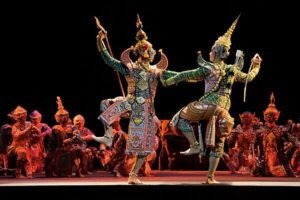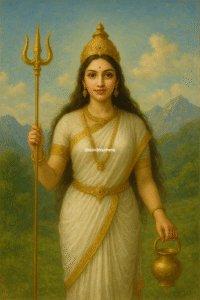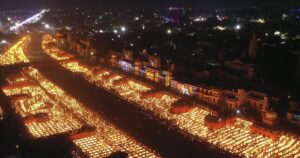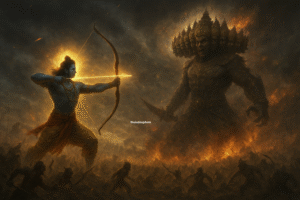
High in the Himalayas blooms a flower of profound significance – the Brahma Kamal. Known for its rare beauty, spiritual symbolism, and medicinal properties, this flower has captivated the hearts and minds of people for centuries. Revered across various religions and deeply embedded in ancient literature, the Brahma Kamal is considered a divine blossom with a unique connection to Bhagwan Brahma, the Hindu god of creation.
A Botanical and Spiritual Marvel
The Connection Between Brahma Kamal and Bhagwan Brahma
The Brahma Kamal belongs to the Asteraceae family, resembling a lotus with its white or pale pink petals enclosed in greenish-yellow bracts that resemble a protective cup. This distinctive flower holds immense cultural, spiritual, and medicinal significance, symbolizing resilience, purity, and divine grace. The flower’s name directly links it to Bhagwan Brahma, the creator god in Hinduism, reflecting its divine status and spiritual importance. Brahma Kamal, which blooms under the moonlight and emits a sweet fragrance, has long been celebrated for its mystical aura, divine connections, and unique beauty.
1. Etymological Reference:
The name “Brahma Kamal” itself establishes a direct link to Bhagwan Brahma. “Brahma” refers to the Hindu god of creation, while “Kamal” means “lotus” in Sanskrit. Thus, “Brahma Kamal” translates to “the lotus of Brahma.” The lotus is a powerful symbol in Hinduism, representing purity, spiritual enlightenment, and the unfolding of creation, much like how a lotus flower blooms from the depths of a pond. By being named after Brahma, the flower is associated with the divine act of creation and the cosmic cycle of life.
2. References in Hindu Mythology:
a. Brahma and the Lotus of Creation:
In Hindu cosmology, Lord Brahma is often depicted seated on a lotus flower, signifying purity and spiritual authority. According to Hindu creation myths, Brahma emerged from a lotus that sprouted from the navel of Lord Vishnu, who rested on the cosmic ocean. This lotus is considered a divine manifestation, representing the birth of the universe itself. While there is no explicit mention of the Brahma Kamal as the exact lotus associated with Brahma’s birth, the flower is named in his honor, symbolizing his role as the creator and the divine essence of life.
b. The Skanda Purana and Vishnu Purana:
The Brahma Kamal finds mention in the Skanda Purana and Vishnu Purana, where it is associated with Lord Brahma’s creative powers. According to these texts, Lord Brahma meditated upon this flower, invoking its spiritual and life-giving qualities. The Brahma Kamal symbolizes the divine energy of creation, purity, and cosmic balance. It is believed that the flower’s petals represent the cycle of creation, preservation, and destruction – the fundamental processes of the universe.
Brahma Kamal in Ancient Literature and Scriptures
1. Buddhist Texts
In Tibetan Buddhism, the Brahma Kamal is revered as a symbol of purity, spiritual awakening, and enlightenment. The flower’s ability to bloom in the harsh conditions of the Himalayas is seen as a metaphor for overcoming life’s difficulties to attain spiritual enlightenment. The flower’s nocturnal bloom, which occurs in the silence and stillness of the night, is considered an apt reflection of the soul’s quiet, persistent journey towards spiritual realization. Tibetan texts also mention its use in traditional medicine, where it is believed to have protective and healing properties.

2. Ancient Ayurvedic Texts
The Brahma Kamal is also praised in ancient Ayurvedic texts like the Charaka Samhita and Sushruta Samhita for its powerful medicinal properties. These texts describe the flower as a potent herb with antibacterial, anti-inflammatory, and antifungal properties, used to treat wounds, cuts, respiratory ailments, and fever. It is regarded as a powerful healing plant in Ayurveda, further underscoring its importance in traditional medicine.
Symbolic Significance and Cultural Connections
a. Symbol of Divine Creation:
The Brahma Kamal is more than a flower; it is a symbol of divine creation, purity, and cosmic energy. It is said to embody the essence of the cosmic lotus from which Brahma was born. The flower symbolizes the creative energy that sustains the universe, much like Brahma himself. Its nocturnal bloom under the moonlight, in the highest and most inaccessible Himalayan altitudes, further adds to its mystical allure and divine symbolism.
b. Sacred Flower in Worship:
The Brahma Kamal is frequently used in religious offerings, particularly in temples dedicated to Lord Brahma and other deities in the Himalayan region. It is considered one of the most auspicious offerings, believed to bring blessings, spiritual growth, and divine grace. This practice reinforces the flower’s sacred association with Brahma and its importance in Hindu worship and spiritual practices.

Conservation Concerns and Experiencing the Brahma Kamal Bloom
Despite its revered status, the Brahma Kamal faces threats from climate change, habitat destruction, and over-harvesting. The flower’s natural habitat is shrinking due to rising global temperatures and increased human encroachment. To protect this rare flower, it is essential to raise awareness, promote sustainable harvesting practices, and preserve its natural habitat.
To witness the rare bloom of the Brahma Kamal, consider trekking to the higher altitudes of the Himalayas during the monsoon season, typically from July to September. The Valley of Flowers in Uttarakhand is a popular destination to experience this flower in its natural setting. Remember to practice responsible trekking and eco-friendly practices to help preserve this delicate and sacred ecosystem.
Conclusion
The Brahma Kamal is a flower that embodies the essence of the divine, a manifestation of nature’s purity, and a symbol of spiritual resilience. Its references in ancient literature, scriptures, and folklore reflect its deep-rooted significance in Hindu mythology and beyond. Whether viewed as a botanical marvel, a spiritual symbol, or a medicinal herb, the Brahma Kamal continues to captivate hearts and inspire reverence, reminding us of the sacred beauty that resides in the natural world.
Have you experienced the divine bloom of the Brahma Kamal? Share your stories and reflections in the comments below!






